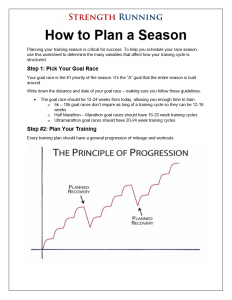Longevity. If I had to pick one word to define my ideal relationship with running, that would be it.

Sadly, these adjectives are probably far more common for many runners: Stress. Injury. Running Burnout.
No matter how much we love to run, we’re all susceptible to one of those three challenges at some point. Smart training and strength work can greatly reduce your injury risk. Finding a sustainable balance between family, work, and running can also help decrease stress.
When losing your enthusiasm for running goes from days to weeks to months, then you’re faced with running burnout. This can be challenging for even the most seasoned runner to come back from. But finding joy in the process of training, even when it’s hard, is what keeps runners in the sport for decades.
Even when you’re training for the thing you love to do the most, there will be times that it’s not enjoyable. And that’s ok!
But learning how to manage and recover from those times is the difference between a short-term dip in enthusiasm, and feeling overwhelmingly burned out from your running.
How I’m Avoiding Running Burnout

At the start of the New Year, looking ahead at my racing schedule felt daunting. While all of my major races have their own specific challenges, how could I continue to enjoy the process of my training through all its ups and downs?
While I have several shorter races scheduled throughout the year, my major races for 2019 include:
- Hyner 50k in April
- World’s End 100k in June
- Eastern States 100-miler in August
These are all part of the Pennsylvania Triple Crown series, described on their website as “Rugged. Dramatic. Punishing.”
They sure know how to sell it!
With many ultra races filling up so far in advance, it’s essential to register early or you’ll miss out. But it also creates a lot of time and need for long term planning. With my longest, most challenging race in August, I was looking ahead to over 7 months of training.
Multiple big races require an ongoing balance of training and recovery time to prevent running burnout. Having the tools to approach this in a way that allows me to enjoy the process is essential so that my enthusiasm and energy are still there to tackle the most challenging race I’ve ever faced.
I’ll use these 9 tools to avoid running burnout and thrive in 2019.
1. Set Sound Goals
Enjoying the process of training and racing begins with setting appropriate goals. There are so many fun races out there that it’s easy to get overenthusiastic and sign up for too many! Picking too many races, too close together, can take the joy and excitement out of racing and training.
When selecting multiple races, make sure that they make sense over the course of your training cycle. Even though I will mix in some shorter, speedier races, I love how my three races progress in length and intensity over the course of the season.
Also, know which races you want to select as your primary focus, or “A Race,” as opposed to those you may race for fun or use as a training run.
You may also want to set training goals like:
- Nail 5×1000 meter repeats at your goal 5k pace
- Run 15 marathon pace miles
- Hit a certain amount of climbing/elevation gain over the course of a week
In addition to races, training goals give you a shorter-term focus when your goal race seems far away.
2. Use Motivation (But Stay Disciplined)
Let’s be honest – motivation sounds way more fun than discipline. But even though running motivation can be a wonderful inspiration for your training, it’s often unreliable over the long haul.
Discipline may be less sexy, but when motivation waxes and wanes, discipline is a reliable friend who is always there for you. Long-term consistency and discipline are necessary to discover the path to enjoyment.
In a long training cycle, enjoyment may not always mean “fun” in the sense that we commonly think of it. Instead, enjoyment comes from a consistent, steady effort.
And as you continue to accomplish your goals, enjoyment comes from long-term satisfaction of knowing you put in the time and effort necessary to push yourself.
3. Think Long-term (short-term too!)
As I mentioned earlier, long-term thinking and goal setting are essential to planning your training. But there is a time and place to look at the big picture and a time to stay focused in the moment.
Begin by thinking about what you want to achieve broadly in the big picture, but then work on the specifics in smaller increments. A coach can assist in breaking down a training plan into smaller, less overwhelming components. He or she may even give you a plan for only 1-2 weeks at a time, allowing room for adjustment along the way.
Sometimes even a week of training or a long run can feel overwhelming if you’re fatigued or juggling other life stresses. Taking one mile at a time may sound trite, but it’s essential.
Take each run and each mile as it comes, and if the feelings of overwhelm persist, then it may be time to cut back or take an extra 1-2 days of rest.
4. Follow a plan… But be flexible
Following a well-constructed training plan, whether it’s designed by you or a coach, is essential to a successful training cycle. If you’re a type A personality who likes to nail every workout and follow every plan down to the last detail, it can be a challenge to allow yourself to take a break when you need it.
Though he wasn’t talking about running, Kenny Rogers wisely sang:
You’ve got to know when to hold ’em
Know when to fold ’em
Know when to walk away
And know when to run…
Knowing when to push through and when to take a break is key to avoiding running burnout. Sometimes it can take just as much discipline to take a rest day as it does to push through a scheduled workout.
If you need help modifying your training schedule, this video shows you how:
Walking away when you’re overwhelmingly fatigued, stressed, or on the brink of injury is always the best decision.
5. Balance Hard and Easy
Training should always include a balance between hard and easy days. While it may not sound like a lot, only about 15-20% of your running should fall into the “hard” category. Similarly, it helps to alternate 4-6 harder weeks with an easier cutback week.
Keeping your easy days truly easy can be a challenge for some of us, so it’s important to learn to listen to your body. Running by effort is an important skill.
Know that your easy pace isn’t set in stone – it may vary with your fatigue level and even time of day. My own easy pace may be nearly a minute per mile faster on an afternoon run when I’m well rested, as opposed to when I’m out in the cold and dark before work at 5 am.
On the easy days, leave your watch at home or don’t pay attention to your splits. Tracking your heart rate on easy days may also be useful.
Ensuring your easy runs are truly easy is a surefire way to prevent running burnout and potentially over-training syndrome.
6. Never Judge a Run By the First Mile
Let’s face it: when you’re in a long training cycle, some days can feel like a slog. Not every run is going to feel good, though most should feel better at the end than they do at the beginning.
Fatigue and tightness are normal early in a run, especially when you are running higher mileage, or even early in the morning before your body has had a chance to loosen up.
Give yourself a chance to ease into a run, but always pay careful attention to any sharp pains that don’t improve over the first mile or two. You may want to use a foam roller to help yourself warm up even more thoroughly (get our free foam roller PDF guide here).
I’ve had a few of my best workouts on days when the first mile felt absolutely terrible. So it’s important to keep an open mind and know that your body may be more resilient and energetic than you think.
7. Get Specific (But Vary Your Training)
When preparing for a goal race, it’s essential to tailor your training to what you’ll face on race day. Typically training gets more specific the closer you get to your event.
If you’re training for a marathon, this may mean gradually increasing the number of goal pace marathon miles you run in a workout as you move out of the base training season. If you’re training for an ultra, you may focus on elevation or navigating technical terrain.
What’s important to recognize, however, is that devoting too much of your time to race-specific training may leave you feeling less enthused once race day actually arrives. There’s a fine line when it comes to training and preparation, and it’s important to avoid crossing it.
Variety always complements specificity. Vary your training by:
- Change your running route if you typically run the same loop
- Run at a different time of day
- Wear different shoes to vary the stress your feet and lower legs experience
- Complete different types of workouts that you’re not used to
During my preparation for my last several road marathons, every few weeks I would get out to the trails for my long run. Yes, this was less race specific.
But since trails are typically my happy place, adding them to my training plan was worthwhile and kept me looking forward to the longer miles.
8. Prepare Your Mind, Not Just Your Body
Taking time for mental training in addition to physical training is another key to enjoying the process of a long training cycle. Mental training and preparation can be both abstract and practical.
It may be as simple as reviewing your training and race plan, and then evaluating where you’re at in your training cycle either in your head or on paper.
Mental preparation can also be a tool to help reduce feelings of overwhelm or anxiety about runs or races. Try visualizing yourself as you successfully tackle your next workout or race. Consider the positive and negative feelings that may arise, and how you’ll handle them.
If an upcoming race is making you anxious because of the distance or your own expectations, take time to look back and look ahead. Looking back by reviewing your training log can help you gain confidence in your preparation.
Looking ahead and plan as many race details as possible:
- travel itinerary
- course route
- fueling plan
- pace/race strategy
By planning as much as possible beforehand, you’ll avoid running burnout, feel more prepared, and be less worried.
9. Keep it Fun
While there is a time and place for serious training, sometimes you just need to get out there and have fun. After all, most of us run because it’s something we enjoy, not because it’s our profession or source of income.
When your training starts to feel stale or monotonous, find ways to switch it up:
- Try running with friends if you usually go solo
- Explore new places, whether it’s roads or trails
- Leave your watch at home and just run by feel and enjoy your time outside
- Switch your workout days around
- Listen to music or a podcast if you typically don’t
When you run or race with friends, try to focus on your own training and development as a runner rather than falling into the comparison trap. While social media is a great way to stay connected and share your training, it can also feel overwhelming if you don’t think you’re doing enough compared to other runners.
Trust your coach and your plan and run for you, not for others.
Longevity in running is only attainable if we enjoy the process. Finding ways to navigate the ups and downs of training and keep it fresh and fun will keep you coming back year after year to the sport you love.
Get the Season Planner Worksheet
I’ve created a free worksheet to help you do this on your own.
It includes highlights from the video, plus:
- Example tune-up race scheduling
- The best tune-up race distances for 5k – marathon races
- The 3 ingredients to a successful season
I want to make your next race a HUGE personal best.
It all starts with a good plan, so make sure you sign up here to get your free Season Planner Worksheet.